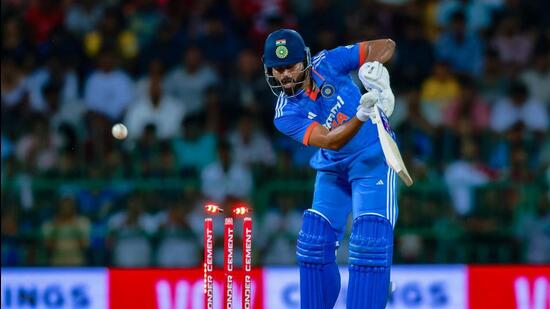
Can India sort out a middling middle order?
7 months ago | 70 Views
New Delhi: Seldom in India’s sporting landscape do its cricketers escape the gaze of sharp scrutiny for their performances. But with the Olympics in full swing in Paris when India were playing in Sri Lanka in Gautam Gambhir’s first assignment as head coach, the attention for once was away from the cricketers.
It’s just as well because the ODI series in Sri Lanka didn’t make for pleasant viewing from India’s perspective. The batters were in for a rough time, undone by Sri Lanka’s pack of shrewd slow bowlers on spin-friendly tracks at the R Premadasa Stadium in Colombo. The outcome was a 2-0 win for the hosts in the three-match series, India’s first series defeat to Sri Lanka in 27 years. So long ago that it would be disingenuous to simply brush it under the carpet.
At the heart of India’s travails was the middle order failing to step up. In three matches where the targets were all below 250, although batting second was ostensibly harder, it fumbled repeatedly. This, despite Rohit Sharma getting the team off to rollicking starts with scores of 58 (47b), 64 (44b) and 35 (20b).
Granted that the ball did spin considerably once the sheen wore off, and the Sri Lankan bowlers were probingly accurate, but it wasn’t anything that these batters hadn’t previously encountered. Particularly once Rohit and Shubman Gill stitched together opening stands of 75, 97 and 37, the likes of Shreyas Iyer, KL Rahul, Shivam Dube and Rishabh Pant in India’s middle order should have been able to use their experience and knowhow to knock off the remaining runs.
Instead, each of them averaged below 20 for the series, responsible for the heap of wickets that fell through the middle overs in all three matches. In total, India lost 27 of their 30 wickets to spin, the most by any team in a three-match series.
“They (Sri Lanka) were consistent with sweeps, taking their chances,” Rohit observed in the aftermath. “There weren’t a lot of runs scored down the ground. They didn’t use the feet as much as we expected. It was about using sweeps and piercing that deep square leg and midwicket field. That is something we failed to do as a batting unit. We didn’t play enough sweeps, reverse sweeps, or paddle sweeps, and used our feet too much. That was the difference.”
Perhaps fresh in Rohit’s mind when he alluded to the use of feet was Rishabh Pant’s dismissal in the third ODI. Just eight balls into his innings, Pant charged down the track against the mystery spin of Maheesh Theekshana. As much of a mystery in the end was Pant’s intention, his bat groping in vain at a ball that spun sharply to leave him stranded almost midway down the pitch.
But Pant wasn’t alone in succumbing due to ineffective footwork against spin. If Pant took the route of skipping down a couple of steps in his only appearance of the series, there were others who paid the price for staying rooted to the crease. Dube and Iyer come to mind. India didn’t sweep as often as Sri Lanka did, but on the few occasions that they did, they also lost more wickets in comparison to their counterparts.
While India won’t be pressing the panic button, what they shouldn’t overlook is the recurring uncertainty about the middle order. Ever since the exits of Yuvraj Singh, MS Dhoni and Suresh Raina from India’s ODI set-up quite a few years ago, the occupants at Nos. 4, 5 and 6 have been prone to bouts of inconsistency a bit too often. The middle order muddle, of course, was the most pressing discussion in the post-mortem to the 2019 ODI World Cup semi-final loss.
And until two months before the ODI World Cup at home last year, there was a sense of déjà vu as Iyer and Rahul were recalled after long-term injuries to spark scepticism about the middle order’s readiness for a big event.
Those concerns were allayed soon enough as Iyer and Rahul got going, ultimately playing critical roles in India’s unbeaten run to the final. But instead of building on that over the past few months, both players have arguably slid down the ladder. In Iyer’s case, a seeming lack of desire to play the Ranji Trophy for Mumbai led to his omission from the BCCI’s list of centrally contracted players for 2023-24. He had a chance to make amends once he was brought back for this ODI series against Sri Lanka — this is the only format where he is currently part of India’s plans — but 38 runs in three games at 12.66 isn’t what he was looking for.
Rahul, too, was underwhelming. Favoured over Pant in the first two ODIs for the sake of continuity perhaps, he was out slog-sweeping on 31 in the first game. That was alright but exposing his stumps in an attempt to play a booming drive off just his second ball in the second ODI wasn’t. The team management thought so too, for he was dropped for the third ODI.
It may have been a case of form deserting Iyer, Pant and Rahul in this series. But there are more fundamental questions to be asked of Dube. With Hardik Pandya excluded from the ODI series — his fitness was enough of an issue for the selectors to look past him for the T20I captaincy — the 31-year-old from Mumbai had a chance to make his case as an alternative. Much like in the T20 World Cup, though, Dube spurned his opportunities. Especially by falling leg-before with a run to get for victory in the opening ODI.
If India remain among the favourites going into the next marquee event — the ICC Champions Trophy in February 2025 — it’s because of a skilful bowling attack and a top three that comprises two greats and a generational talent. It’s now for the middle order to also get its act together.
#




















